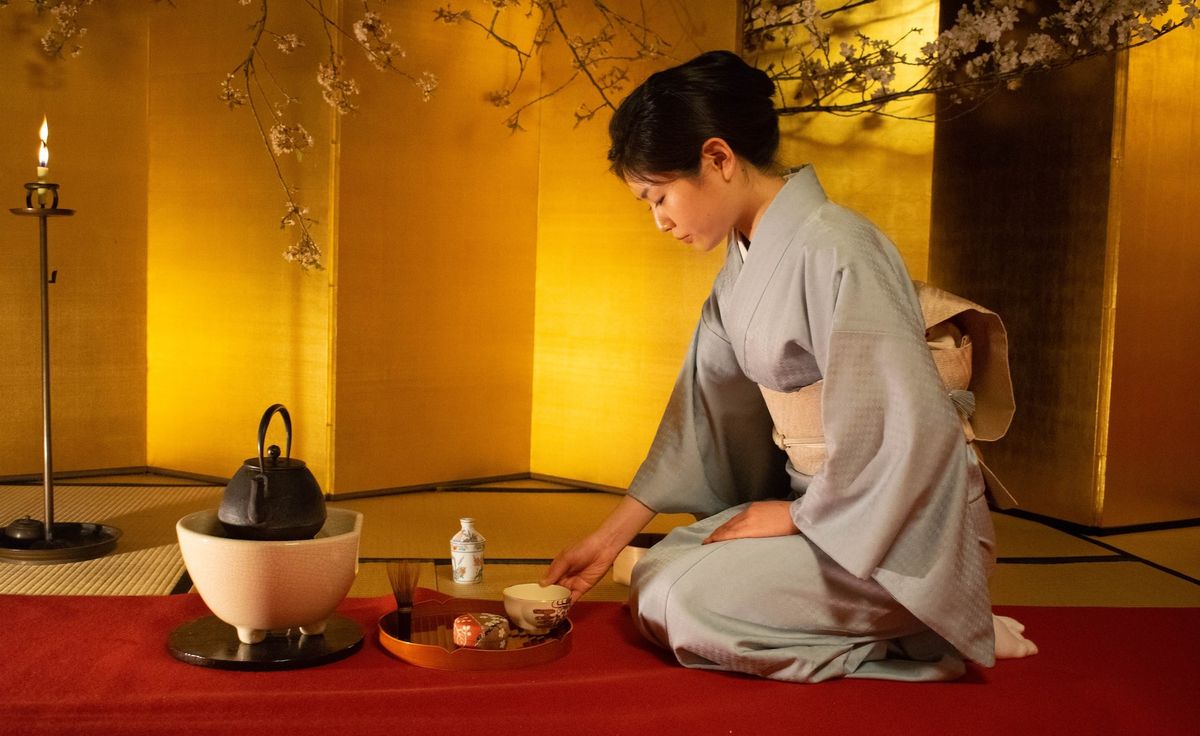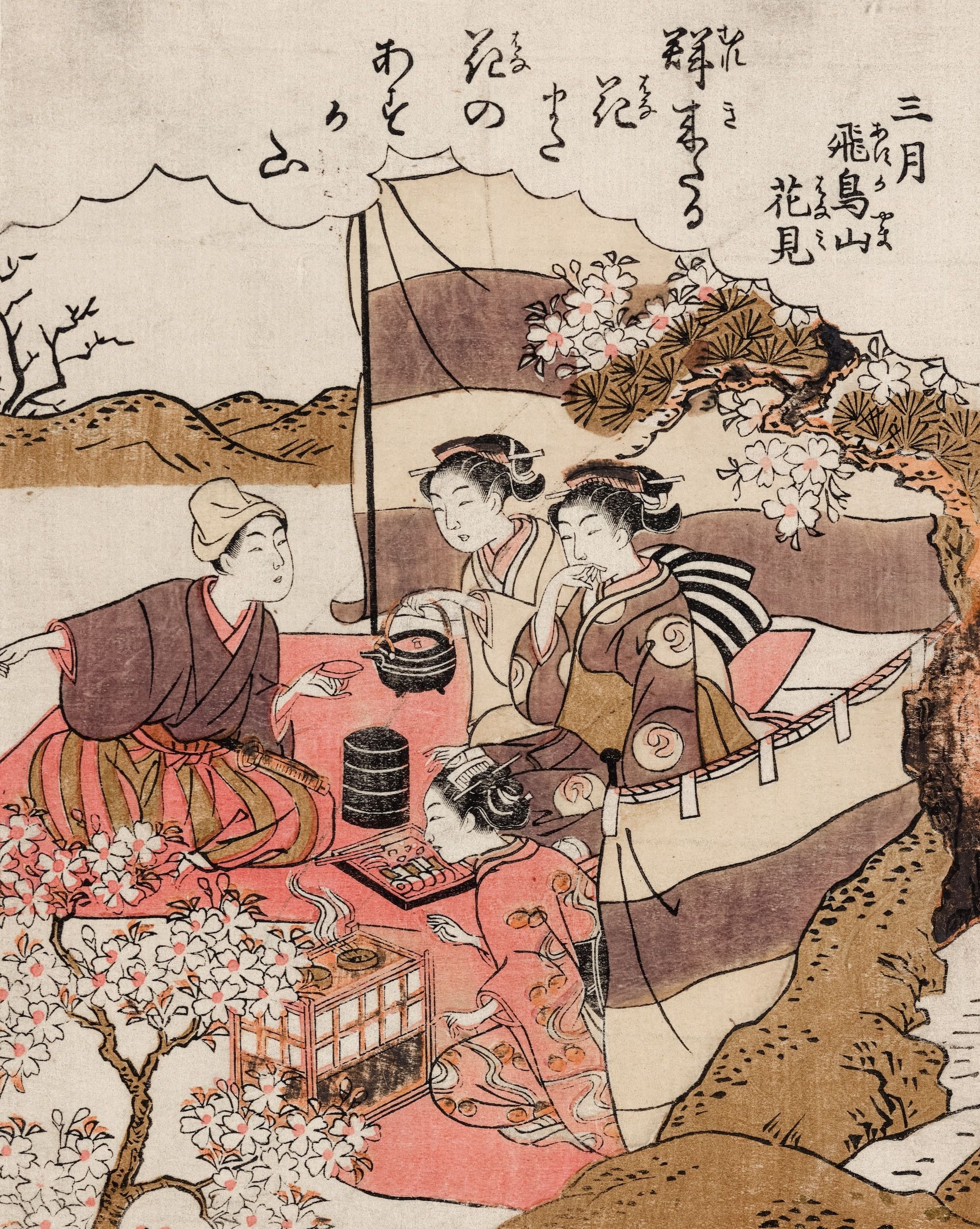The Traditional Japanese Tea Ceremony
The traditional Japanese tea ceremony, also known as "chanoyu" or "sado", is a ritualistic preparation and consumption of matcha.

What is Tea Ceremony in Japan?
The Japanese tea ceremony, known as "sadō" or "chadō" (茶道, signifying "the way of tea"), and also referred to as "chanoyu" (茶の湯, denoting "tea's hot water"), is a time-honored cultural ritual of Japan.
It revolves around the careful preparation and consumption of green tea in settings typically adorned with tatami flooring. However, "chanoyu" transcends the act of merely drinking tea. It's an experience that offers participants a serene interlude from the rush of everyday life, all while basking in the generous hospitality of their host.
Historical Origins
In the 8th century, Japan embraced tea, an import from China, but initially, its use was restricted as a medicinal elixir for the elite and the clergy. However, by the Muromachi Period (1333-1573), its appeal had broadened, reaching all societal layers.
While the affluent engaged in extravagant tea parties, showcasing their prized tea bowls and expertise, a contrasting, Zen-influenced form of tea gathering emerged.
This minimalist and spiritually-oriented approach eventually evolved into what we recognize today as the Japanese tea ceremony.
The transformation of this ritual owes much to Sen no Rikyu (1522-1591), who championed a philosophy of rustic simplicity. His legacy persists, as evident in renowned tea schools like Omotesenke and Urasenke.
Which Tea Variety is Used in Japanese Tea Ceremony?
Matcha, a fine green tea powder, plays a pivotal role in the Japanese tea ceremony. Its distinctive green hue results from the non-roasted and non-fermented processing of the tea leaves.
To achieve its powdery consistency, the leaves are traditionally ground using stone grinders. Uji, situated in the southern realms of Kyoto, is renowned for its premium matcha production.
By April, the cultivation pace of matcha leaves typically diminishes, paving the way for a hand-picked harvest in May. After harvest, the leaves are steamed, dried, and then meticulously ground on stone.
At establishments like Maikoya, there's a commitment to offering matcha of superior grade sourced from Kyoto. The quality gradient between matcha grades becomes palpable, especially in lighter concoctions such as usucha.
When Do Japanese Tea Ceremonies Occur?
The Japanese tea ceremony, distinct from its Chinese counterpart, marks seasonal transitions and events like cherry blossoms, autumnal foliage, tea harvests, and the dawn of a new year.
Not a daily ritual due to the prevalent use of boiled tea leaves and lack of specialized tea rooms, it's still cherished by enthusiasts and school groups. While casual tea gatherings (chakai) are open to all, the formal chaji, paired with a kaiseki meal, is for the well-versed.
The Etiquettes of the Japanese Tea Ceremony
Japanese tea ceremony decorum emphasizes punctuality, clean socks, and maintaining silence. Remember to remove shoes upon entry, set phones to silent, offer a bow to the host, and avoid strong scents.
Traditional attire like a kimono is preferred, but conservative dress is acceptable. Concealing jewelry is suggested but not compulsory.
While silence is essential during tool purification, participants should appreciate the tea bowls and seasonal flowers afterward. Conversations initiated by the host should center around the ceremony and seasons.
Advanced attendees are expected to bring paper fans and kneel throughout, but newcomers aren't held to these standards.
While tradition suggests sweets be eaten in three bites and tea consumed in three sips, these aren't stringent rules for foreigners.
However, a commonly overlooked etiquette by beginners is the "slurping sound" made after tea consumption, signaling enjoyment and completion.
The Procedures and Rituals
The tea ceremony, or "temae" in Japanese, can be informal (chakai) or formal (chaji). Chakai, often termed a typical gathering, spans about 45 minutes but requires years of training. Conversely, chaji, overseen by veteran tea masters, extends up to four hours, inclusive of a traditional kaiseki meal.
Seasonal shifts dictate the specific rituals. Let's look into the steps of the basic shozumi ceremony that incorporates a kaiseki meal:
- Preparation: The tearoom and surrounding gardens are meticulously cleaned. Invitations are dispatched weeks prior. The tea room, devoid of chairs and tables, features woven tatami mats for seating. Paper-made doors and mats, when cleaned, often need replacing. For a comprehensive ceremony, guest preferences on tea and food are sought.
- Meal Prepping: The preceding day sees the preparation of the kaiseki meal: an array of dishes spotlighting rice, vegetables, and soup. Recognized for premium ingredients and presentation, these meals are complemented with Japanese sweets to counteract the tea's bitterness. Simpler alternatives cater to newbie participants. Before commencement, hot water is readied in the 'kama', an iron pot.
- Welcome: Guests are ushered into the tea room by the host, or 'teishu'. The necessary utensils are either already positioned on the tatami or introduced shortly after. Essential host gestures include fluid standing motions and frequent bows. The kaiseki meal is then served.
- Post-Meal Rituals: After the meal, sweets are ceremonially offered to the principal guest. In comprehensive ceremonies, the guest's societal status dictates their specific roles. The principal guest, or 'shokyaku', receives the sweets and typically inquires about the utensils' origins.
- Tea Preparation: This stage, usually silent, involves intricate steps like lifting the tea bowl or 'chawan' with a tea whisk inside.
- Setting the Scene: The host positions the tea jar, or 'natsume', in front of themselves. After wiping it with a silk cloth, it's set near the cold water container. Holding the cloth, the tea scoop or 'chashaku' is cleaned and placed atop the jar.
- Preparation: The tea whisk, 'chasen', is laid beside the tea jar. Using a ladle, 'hishaku', the host uncovers the warm iron pot, scoops hot water, and pours it into the tea bowl. The bowl and whisk are rinsed with this water, which is later discarded into a wastewater receptacle. The bowl is dried with a hemp cloth.
- Making the Tea: The tea scoop and jar are used to deposit one and a half scoops of matcha into the bowl. Hot water from the iron pot, 'kama', is poured over. Mastery is revealed in achieving the right matcha-to-water ratio. The whisk ensures the tea has a pale green foam, ideally concentrated at the bowl's center.
- Serving the Guests: After a final cleaning of the bowl's lip, it's handed to the primary guest, 'shokyaku'. As the first taster, only they can comment on the tea's quality. Once done, the bowl is rinsed, refilled, and served to successive guests in the same manner. After everyone's served, the shokyaku confirms everyone is satisfied.
- Cleanup: The host meticulously cleans each tool, discreetly handling the wastewater bowl. Freshwater replenishes the kama, replacing what was used. Most equipment is returned to the tea house's preparation zone.
- Closing Ritual: Concluding the ceremony, the host kneels by the entrance, expressing gratitude for the guests' presence.
Spiritual Foundations
The Zen Buddhist principles deeply influence the tea ceremony. Every step, every movement is deliberate and seeks to cultivate mindfulness. The ceremony, in its entirety, is a meditation in action – an expression of 'ichigo ichie', a concept that emphasizes the uniqueness and impermanence of each moment.

The Artistry of Tea Ceremony Instruments
Every element within the Japanese tea ceremony, no matter how seemingly minor, carries profound significance. Especially noteworthy are the tools, which are not only functional but also represent deep cultural and artistic values.
- Chawan (Tea Bowl): Perhaps the most recognizable tool, the chawan is more than just a vessel for tea. Its shape, size, color, and texture play a crucial role in the aesthetics of the ceremony. Bowls may be rustic or refined, each telling a different story about its origin, the season, or the ceremony itself. Some chawans, especially those crafted by renowned potters or having historical significance, are highly prized.
- Chasen (Bamboo Whisk): Crafted from a single piece of bamboo, this delicate instrument’s elegance lies in its functionality. With its fine tines, the chasen is meticulously hand-carved, a testament to the artisan’s skill. It ensures the matcha is perfectly frothy, marrying form and function seamlessly.
- Chashaku (Tea Scoop): Another bamboo-made instrument, the chashaku is a symbol of simplicity in the ceremony. Each scoop is subtly curved, often resembling a stretched leaf, and it measures the precise amount of tea required.
- Natsume (Tea Caddy): Named after the jujube fruit it resembles, the natsume is often lacquered and adorned with intricate designs. It houses the precious matcha powder and can be made from various materials, including rare woods or high-quality metals.
- Kama (Iron Kettle) and Furo (Brazier): Used to heat the water, the kama is typically iron-made, representing endurance and longevity. The brazier, on the other hand, is both a heat source and an artistic statement, often crafted to reflect the season or theme of the ceremony.
- Kensui (Waste Water Bowl): This seemingly mundane vessel holds significance, emphasizing the importance of cleanliness and purity in the ceremony. Often made of ceramic, its design is a subtle nod to the imperfections and naturalness cherished in the tea ceremony.
Attire
The attire worn, especially by the host, is traditional Japanese clothing like the kimono, complemented by accessories that highlight the season or the theme of the ceremony.
The Luxury Aspect
While many think of the tea ceremony as a humble affair, there is a luxurious side to it that is both subtle and grand. Exclusive tea houses, often hidden amidst verdant gardens, are architectural masterpieces built with rare woods and adorned with exquisite artworks. The utensils used, ranging from the tea bowl to the bamboo whisk, are often handcrafted by master artisans, some of which can be worth thousands of dollars.
Tea Rooms and Gardens
The tea room, or 'chashitsu', is central to the ceremony. These rooms, usually small and intimate, are designed to embody simplicity ('wabi') and quiet refinement ('sabi'). Every element, from the low entrance (forcing guests to bow, promoting humility) to the tatami mats, has symbolic meaning.
Surrounding the tea room, one often finds the 'roji' or the tea garden. This is not just any garden; it's a carefully curated path meant to prepare the guests mentally for the tea experience. The journey through the garden is symbolic of leaving the mundane world behind.
What Makes the Japanese Tea Ceremony Culturally Significant?
The significance of the tea ceremony in Japanese culture is profound. Historically, it was an exclusive practice reserved for esteemed Zen monks and noble warlords. Today, while some in Japan treat it as a recreational activity, it's predominantly revered as a traditional art, often referred to as the "art of tea."

Beyond the Ceremony
More than just a method of preparing tea, the tea ceremony encapsulates a philosophy. It promotes ideals like harmony ('wa'), respect ('kei'), purity ('sei'), and tranquility ('jaku'). It is a way of life, a discipline that emphasizes the beauty in every moment and every detail.
In today’s fast-paced world, the luxury tea ceremony stands as a testament to the value of slowing down, appreciating beauty in all its forms, and connecting with others in meaningful ways. It’s not just about drinking tea; it’s about savoring life, one sip at a time.


